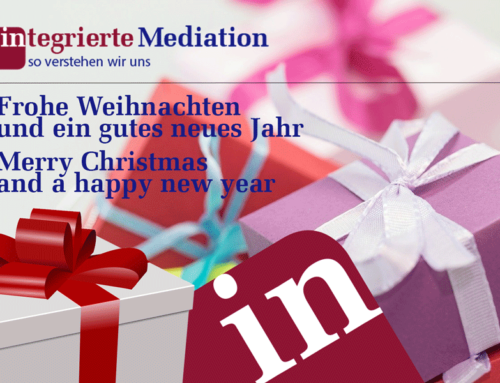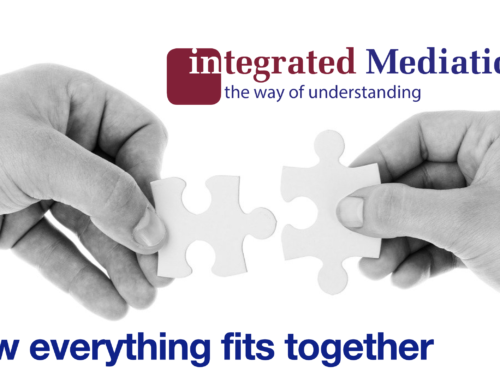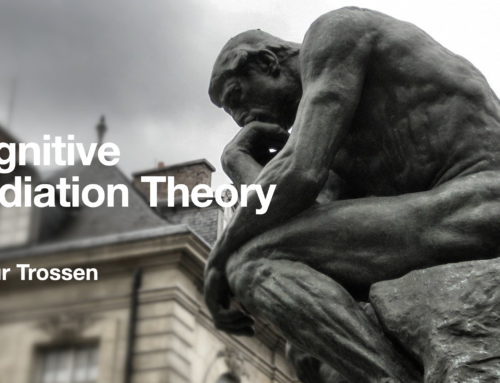Mediation – path of knowledge
The term mediation is often used synonymously with the idea of a friendly out-of-court dispute settlement. Others say it’s a superfluous small talk. Experts also value mediation very differently. Some compare mediation with a compromise similar to settlements in legal negotiations. Others even think, mediation is close to the juridical competence of resolving conflicts. They all are wrong.
Mediators know that there is much more behind. But what exactly is the competence of mediation and what is distinguishing it from other procedures and negotiations? The key to answering this question comes up, when mediation is seen a cognition process. When it is understood like a path of knowledge in a philosophical understanding, which is a way of insights for gaining insights. The key also serves to understand Integrated Mediation.
The mediation theory
Anyone looking for a science-based theory of mediation will encounter the Harvard concept (Getting to Yes). In fact, the research of Roger Fisher and William Ury proves some important negotiating principles that can be found also in the principles of mediation. Then the escalation theory of Friedrich Glasl is mentioned and the consensus principle as well. There are other scientific fragments that can be used to describe single phenomena of mediation. Of course, communication theory plays an important role when we need to explain the process of understanding in mediation.
The complexity of mediation and its interdisciplinary approach surely allow further attempts to explain other phenomena appearing in mediation. However, none of these fragments, even not the sum of them can fully describe the internal context and functionality of it. Only the cognition theory provides a comprehensible approach, which deals with the question of what holds the mediation together in the innermost in order to formulate it with the words of Goethe’s Faust.
What we want to know is why what is working how, to achieve those convincing results as they happen in mediation. Knowing about is the most intriguing competence for doing the mediation properly.
The starting point
The starting point of insights is to realize that mediation is different. The difference is embedded in a concept where it is solely up to the parties to find a solution. That means that it is up to the mediands who have to go the way of thought. The mediator’s task is to enable the parties thinking in a mediative, solution-making way. In order to accomplish this task, he needs to know the way of thought that enables parties gaining insights helping them to find an amicable solution.
Another difference that delimits the mediation from other solution-oriented methods like e.g. conciliation, obtains from the main focus of mediation. In mediation, the solution is based on understanding. It sets itself apart from the conciliation which emphasize the solution solely. Contrasting the conciliator, the mediator assumes that the solution can be found when parties are fully informed and have mutually understood which thoughts and aspects contribute to finding a solution. In conciliation the solution is given. In mediation it will be developed.
Because of that the focus of mediation always is understanding. Understanding is one of the most important words next to the word complexity characterising the core of mediation. A scientific approach to understanding is provided by cognitive science. The term cognition describes the transformation of information carried out by a behavior-controlling system. It derives from the Latin cognoscere, which can be translated as recognized or experienced. The subject is the study of the processing of information in the context of human thinking and decision-making. Cognitive science covers, among other things, perception, thinking, judgment, memory and language. It is not limited to cognition itsself, but also includes motivation, emotion and volition.
Every mediator will realize that this science deals with issues he constantly meets in mediation. The cognition theory, created by Arthur Trossen and determining the Integrated Mediation, takes up this research and relates it to mediation as a cognitive process.
The agreement
In mediation, cognitions, emotions and volitions are not captured arbitrarily. They need to be correlated in order to achieve the goal of mediation. To recognize what insights are to be processed in mediation, it is crucial to understand what goal exactly it pursues. Many feel that their goal is to just reach an agreement. This definition is not precise enough if mediation is to be delimited from a compromise, a settlement or a conciliation that also ends in agreement.
There are many mediations that are very successful but do not require an express agreement. This is e.g. the case when mediation managed a relationship healing that makes further agreements obsolete. If that aim could be managed by the process of mediation, then it can be called a successful mediation without the need for an explicit settlement.
The consideration makes it clear that the path to solution is not predetermined sufficiently if only the settlement defines the goal. Thus, the goal of the mediation must be fixed ahead of settlement. More precisely, mediation therefore is about finding a solution. That means the goal is reached when the parties have found the solution. Of course, the solution should not be arbitrary. In particular, it should be clear that mediation seeks first and foremost a consensus, not a compromise. To assure the quality of the solution it will be fixed in a target agreement right at the beginning. Crucially, mediation leads to the satisfaction of all parties affected by the conflict. With the specified processing depth, the mediation model (evaluative, facilitative, transformative integrated mediation) to be applied is determined at the same time.
The mediation starts with an agreement and leads to an agreement where many agreements are on its way. Thus agreement is not just the outcome. Its a condition as well. However, the final settlement is already behind the goal as it steps into implementing the solution found. It should help to realize the solution and ensure it is both legally binding and sustainable. So the goal of mediation is to find a solution. The conclusion agreement is its manifestation and a possible outcome of the process.
The search
Where the goal is to find a solution, the way to get there is to search. Consequently, mediation describes a searching process which should lead to a solution which the parties themselves find and which should lead to a situational maximum possible satisfaction. In no case is it an arbitrary search, even if the result should be open. With the search for a solution, the mediation differs from all other procedures, heading to enforce a given solution or to get as close as possible to that.
In order to enable an open-ended search, mediation provides some requirements and framework conditions that make such a search possible even in a confrontational climate. It further defines milestones so that the searchers do not lose their way. The search itself is controlled by mediation. The requirements are:
- Outcome target: The goal is to finding a solution that all parties are satisfied with (agreeing to).
- Clarification of the way: Agreement about the mediation and its rules, so that the parties can actively and securely participate in the search and that they know what to do.
-
Defining the framework: The search expects cooperation. In order to facilitate cooperation even within a confrontation, needs some protection. Open talks require a shelter to assure that the openness of the parties can not be exploited to weaken their position in the confrontation.
-
Establishing the Meta-level: Mediation is a reflexive process. In order to offer this mental access, it is necessary to set up a permanently present meta-level, which is represented by the mediator. To ensure the meta position, the mediator must position himself outside the dispute system, which is ensured by the principle of indetermination and to be find solely in mediation.
-
Fixing Responsibilities: The empowerment of the party to accept only those solutions that it can stand behind, and securing of mutual respect is ensured by the inherent principle of voluntariness.
The way
The search turns out to be a train of thought. It’s about gathering information and putting it together so it can come up with a solution. In contrast to legal procedures, for example, mediation does not focus solely on facts and legal consequences. Rather, it extends to the entire quarrel continuum and all aspects of cognitive-scientific understanding. With this claim mediation opens up the entire complexity of the case and of the procedure the same time. This is the reason why mediation for many looks like a myth, not really tangible. But the truth is, its just very complex. The ability to overcome complexity yields another essential property of mediation.
If you look for the game theory trying to find patterns in the most suitable game fitting to mediation, a puzzle comes in mind. In fact the process of information processing could best be compared with an enigma. The puzzle pieces are the information units that have to be put together in such a way that a picture is created at the end. Actually, these are two puzzles that play together. One concerns the procedure (the mediation), the other the case (the contradiction to be solved). There is an image template for the mediation puzzle, but not for the case puzzle. The puzzle pieces (information) that the mediator finds are not sorted and do not necessarily belong in the pictures to be placed. He’ll find a situation that comes close to the graphic in the header of this post. In order to assign the jigsaw pieces to the one or the other puzzle and to understand how the information can be related, it is crucial to know an ordering principle so that the puzzle pieces can be correctly identified and assembled.
The access to the collection and classification of the information results in its meta-information. Each piece of information (or each puzzle piece) has features that qualify the information. The mediator should know how to read them. To capture and process the complexity, the qualifiers are subdivided into dimensions. The dimensions can be assigned to either the procedure or the case. You can capture anything that has any relevance. The procedural dimensions are more or less fixed. They make up the picture template of the one puzzle. Process-related dimensions are, for example, the qualification for positions, motives (interests) and solutions. The case-related dimensions are formed according to the requirements of the case. So they affect the puzzle, for which there is no template available. Case-related dimensions are e.g. facts, opinions, emotions, relationships, legal relationships, etc.
The logic
By linking information and dimension, all the pieces of the puzzle (information) can be put together to give a picture. Mediators know the effect when the picture suddenly becomes recognized to the parties. Then the solution suddenly falls like ripe fruit from the trees. It is a sign that the information has been put together correctly in the sense of mediation.
The context becomes clear when the dimensions are understood as the convexities of a puzzle stone. The bulges give which stone to match with what. The connection is not accidentally they instead are corresponding to an inner logic. The logical frame of the procedural dimensions, for example, allows the correct assignment to the phases of mediation, whereby they are correctly integrated into the process (the mediative train of thought). The internal logic of the case-related dimensions allows an assignment to the solution-relevant issues. Facts are compared to facts, opinions to opinions. They cannot be mixed up with opinions anymore. Emotions will be recognized and assigned to facts or opinions, uncovering the meaning behind. When it e.g. comes to relationship conflicts, relationship and relationship levels are other dimensions that need to be highlighted to resolve the case.
The mental assignment of the procedural information results from the phase logic. In fact, it supports the cognitive process by influencing the train of thought. It brings thoughts close to the solution by correlating the procedural and case-related dimensions in such a way that one puzzle results from the other. The train of thought described in the phases enables the benefit-oriented, solution-oriented thinking of mediation as follows:
- Phase: This phase serves to define the search conditions described above. The framework creates the exclave in which the mediative thinking (the search process) becomes possible. The goal is to find an open-ended solution for a mutually satisfaction of the parties.
- Phase: This phase starts the actual search process. The dispute is identified to limit the search radius. The parties describe what is wrong. The parties’ positions are accepted as a contradiction that is neutralized by the issue. The recognition of the contradiction and the neutralization of the positions in topics is the first step in bringing the parties’ thoughts out of the dispute.
- Phase: In order to prevent a relapse into the dispute (the arguing), the third phase is strictly separated from the previous dispute phase. There is a significant shift of thought in directing the parties’ thinking in a (hypothetical) direction as to the situation after conflict resolution. The parties are mentally led into an ideal (healed) world that makes commonalities visible. The description of the healing world corresponds to the benefit expectation. The benefit expectation can be derived from the motives (interests). It gives the criteria by which the parties describe their satisfaction and on which the result can be measured. Mediation changes the thinking model by focusing not on logical but on associative thinking. Thoughts will be embedded into a dialectic thinking.
- Phase: When sufficient criteria have been developed in the previous phase for the solution to be found, options to resolve the conflict (solutions) are sought. It is important that the proposed solutions are initially only collected and not discussed. The brainstorming leads to a collection of options, which in a second step are transformed into a dialectical synthesis. The options are evaluated and then checked to see if they match the previously developed criteria. Only in this course the actual negotiation starts. Now controversial questions can safely be uncovered and examined to evaluate how the facts are. Finally, all the options that can be combined in a solution concept will be compared with other concepts of solution, such as the legal solution developed. Thus, mediation ensures that the parties not only compare with other solutions, but also be sure to choose the most optimal solution.
- Phase: The solution found is manifested and checked for its realization, so that its sustainability is ensured.
It should be noted that and how the phases control the train of thought. In doing so, mediation supports a decision-making process that is possible but rather unusual for humans. Normally, a decision-making process is structured as follows: First, the problem is formulated. After an analysis, the solution is developed. After the solution is fixed, the considerations of its realization begin. Long afterwards, the benefits of the decision will become apparent. This type of problem solution can be found in all areas of life. Dealing with Brexit is a prime example. Consensus and benefits are not part of the negotiating process.
Mediation handles the decision-making process quite differently. It reverses the sequence of steps leading to the decision and at the same time expands it. After the definition of the question and the collocation of the reasons, the potential benefit is asked. There is no indication for arguing. When the benefit expectations have been agreed, the possible implementation (realization) is asked. Only after that the decision will be made.
It is also important to note that and how the phases limit thinking and expand it at the same time. By avoiding (hiding) the idea of a solution, the focus can change in the parties’ thinking. The benefit expectation (Phase 3) is a different mental access beyond positions and solutions. The perceptual radius expands. So it can be explained that the mediation comes to solutions that no one had previously considered or even thought possible.
By separating thought sections from each other and concentrating them on different levels (dimensions), it is possible for mediation to combine controversial thinking formats such as logical, dialectical, legal and psychological thinking. The combination is made possible by a sequential, not simultaneous inclusion of the respective way of thinking. The overall result is a reflection taking the whole complexity into consideration allowing everything that helps finding insights like funds of the solution.
Puzzle stones do not just have shapes. They also have motifs. If the pieces of the puzzle represent metaphorically the units of information to be introduced in the mediation, their form yields the logical connection. The thematic connection is mapped by the motifs on the puzzle stones and also recorded as a dimension. Ideally, each topic corresponds to a conflict. This ensures that the thought-through pathway is traversed for each conflict. The classification of conflicts that best correlates with mediation, distinguishes five conflict dimensions: factual conflicts, relationship conflicts, value conflicts, structural conflicts and system conflicts. The conflict dimensions refer to the human centers of intelligence. They at the same time determine the communication level.
The parties
The complexity comes to him. It is not bound to facts and opinions, as in a legal process, and can change the dimensions captured as dimensions until it finds a basis, where similarities appear and where similarities can become the basis for a smart solution. He knows, for example, that the conflict not only clouds perception, but also shows where the problem to be solved actually lies in its depth. In order for the conflict to be involved in mediation and understood by the parties, the mediator pays attention to the fact that every conflict is reflected in one topic adjusted in phase 2. He helps the parties understand the conflict and take responsibility for it. The so-called Rumpelstiltskin effect comes to meet him. Often the conflict dissolves when the parties name the real conflicts name.
Clarifying the conflict is an important step. It is psychologically and possibly sociologically oriented and helps to point out the difference between the problem to be solved and the underlying conflict engine. Clarifying the conflict helps parties to gain insights that can be used to find the real base for a sustainable, satisfactory solution.
The matrix
Integrated mediation
It is obvious that this mental matrix is not limited to mediation in a legal sense. Certainly the so-called pure mediation facilitates its implementation the easiest way. But it does not prevent that the way of thinking following cognitive theory can also be put across other procedures. In virtual terms, elements can be found outside legal mediations as well, helping to complete the mediation substantially. If it succeeds in assigning the functional units to the matrix, process combinations become possible. In the aggregate they complete either a substantial or a formal mediation. Mediation in the legal sense is then, just like any other procedure, only a container that decides which methods, competencies, steps of thought and insights can be collected and integrated in it or not. Thus a consultation e.g. can be enriched with mediation methods that mediation the one or other way will be the outcome. The container theory compares a (formal or legal) procedure with a box like a container, where methods and thoughts can be filling the content. This approach further more allows to stack (connect) or replenish different containers like in a container port. Now the matrix even allows a meta-perspective on the procedures themselves, measuring the effectiveness.
It should be clear now, that Integrated Mediation is nothing else but mediation in cognitive understanding. It also becomes apparent why the Association of Integrated Mediation describes mediation primarily as a way of thinking that results in mediation (as a service) or in mediation in its cognitive support. The idea is expressed in the association’s claim: “The way we understand us”.
Anyone who understands that mediation is an approach embracing all solutions possible, taking into account the full complexity of the issues to be resolved with all the relevant aspects, not giving reason to quarrel but to constructively debate based on insights to be gained mutually does not just influence the demand (when it is known and understood correctly) but also is a mean to improve the culture of dealing with each other in our society. If that sounds good, what could be an alternative?






Leave A Comment
You must be logged in to post a comment.